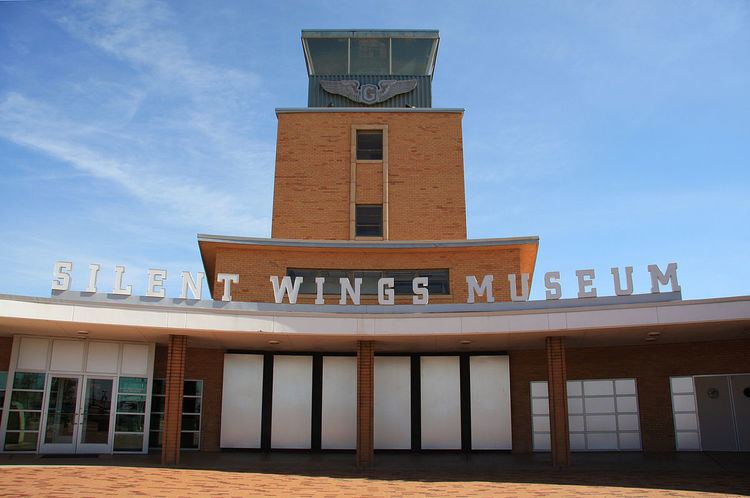Phone +1 806-775-3049 | Type Historical museum Founded 20 October 2001 | |
 | ||
Established 20 October 2001 (2001-10-20) Website Silent Wings Museum - official site Address 6202 N Interstate 27, Lubbock, TX 79403, United States Hours Open today · 10AM–5PMTuesday10AM–5PMWednesday10AM–5PMThursday10AM–5PMFriday10AM–5PMSaturday10AM–5PMSunday1–5PMMondayClosedSuggest an edit Similar American Wind Power Ce, Prairie Dog Town, National Ranching Heritage, Joyland Amusement Park, Buddy Holly Center | ||
Discover the silent wings museum in lubbock texas
Silent Wings Museum, "The Legacy of The World War II Glider Pilots", is a museum in Lubbock, Texas.
Contents
- Discover the silent wings museum in lubbock texas
- Silent wings museum
- History
- Exhibits
- Education and outreach
- Robert Allen Todd
- References
Silent wings museum
History
The museum is located on the site of World War II South Plains Army Air Field, where glider pilots were trained between 1942 and 1945, after which time they were required also to command skills in powered flight. The Lubbock site was chosen for the glider school because of its dry, warm weather, mostly clear skies, and goodwill in the local community. The climate creates conditions of upward air currents and relatively little low-cloud formation, both conditions essential in gliding. The glider training area is now within the scope of the museum and the nearby Lubbock Preston Smith International Airport.
In 1971, former pilots of the U.S. Army Air Force banded together to form the National World War II Glider Pilots Association, Inc. Their mission was to establish a forum for glider pilots to interact socially and provide the framework for the preservation of the history of the U.S. glider program.
One of its first goals was to locate and restore a WACO CG-4A (See CG-4 Hadrian) glider for public display. Several pilots in the Dallas area learned of just such a glider sitting on top of a tire store in Fresno, California. After World War II, the aircraft had been purchased as military surplus, placed on top of the building and used as advertising. In 1979, the glider was purchased, restored and completed in time for the reunion in Dallas. After the reunion steps were taken to build a museum to house the CG-4A.
The first Silent Wings Museum opened to the public on November 10, 1984 in Terrell east of Dallas. By 1997, the need for a more permanent museum home was realized. Lubbock, where a majority of the pilots had trained, offered to provide a new site for the museum. The pilots agreed to the new location, and the Terrell site closed in January 2001. The following October, the former South Plains Army Air Field site opened the new Silent Wings Museum with the restored CG-4A glider as the centerpiece of the exhibits.
Exhibits
The museum features a fifteen-minute program in its theatre entitled Silent Wings: The Story of the World War II Glider Program. Visitors then move on to the Timeline, Hangar and Combat Galleries. Photographs and artifacts, including a fully restored WACO CG-4A glider, TG-4 trainer, airborne equipment, and living exhibit: the British Horsa Glider restoration project.
Education and outreach
Silent Wings makes learning about history a hands-on experience with educational tours, footlocker loan kits and scavenger hunts. Tours can be scheduled and teaching materials can be reserved.
Silent Wings offers a variety of outreach programs and provides speakers that can tailor a program to fit a group's meeting.
The Adams Research Library is located within the Silent Wings Museum. It is home to an extensive archive and book collection about the World War II military glider program. Research appointments can be scheduled.
Robert Allen Todd
Robert Allen Todd (1920-2009), a World War II glider pilot and retired lieutenant colonel in the U.S. Air Force Reserve, served on the first Silent Wings board and was instrumental in relocating the museum from Terrell to Lubbock. A native of Fort Worth, Todd was an artist at the Lubbock Avalanche-Journal from 1948-1985. He graduated from R. L. Paschal High School and received a degree in commercial art from what is now the University of Texas at Arlington. He also obtained a pilots license from Texas Christian University.
Todd trained at South Plains Army Air Field in Lubbock as a volunteer in the Army Air Corps Combat Glider Program. On June 7, 1944, he piloted a glider in the D-Day Normandy invasion. He flew several other missions and was recognized by France with a certificate recounting his service. He also received Holland's highest honor, the Order of the Orange Lanyard for his service in Operation Market Garden. In his later years, Todd returned to painting with oils, capturing the essence of New Mexico's missions and the western expansive landscapes with his work. Todd died on September 14, 2009.
Memorial services were to be held on September 28 at St. Christopher's Episcopal Church in Lubbock on what would have been his 89th birthday. Todd's first wife, the former Maxine Beasley, died in 1979. In 1981, he married the former Blanche Read Trammel. In addition to his wife Blanche, he was survived by a brother, Leslie Todd of Burleson, and children, Ronald Allen Todd of Scottsdale, Arizona; Steve Trammel of Centennial, Colorado; Robert Trammel and Mark Trammel, both of Lubbock, and Marie Kathrine Trammel Rowins of Austin, and eleven grandchildren.
